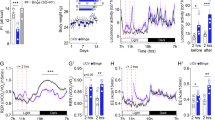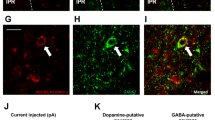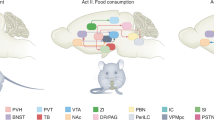Abstract
Excessive consumption of high-energy, palatable food contributes to obesity, which results in the metabolic syndrome, heart disease, type-2 diabetes and death. Current knowledge on the function of the hypothalamus as the brain ‘feeding centre’ recognizes this region as the main regulator of body weight in the central nervous system. Because of their intrinsically fast and adaptive activities, feeding-controlling neural circuitries are endowed with synaptic plasticity modulated by neurotransmitters and hormones that act at different hierarchical levels of integration. In the hypothalamus, among the chemical mediators involved in this integration, endocannabinoids (eCBs) are ideal candidates for the fast (that is, non-genomic), stress-related fine-tuning of neuronal functions. In this article, we overview the role of the eCB system (ECS) in the control of energy intake, and particularly in the consumption of high-energy, palatable food, and discuss how such a role is affected in the brain by changes in the levels of feeding-regulated hormones, such as the adipose tissue-derived anorexigenic mediator leptin, as well as by high-fat diets. The understanding of the molecular mechanisms underlying the neuronal control of feeding behaviours by eCBs offers many potential opportunities for novel therapeutic approaches against obesity. Highlights of the latest advances in the development of strategies that minimize central ECS overactivity in ‘western diet’-driven obesity are discussed.
This is a preview of subscription content, access via your institution
Access options
Subscribe to this journal
We are sorry, but there is no personal subscription option available for your country.
Buy this article
- Purchase on Springer Link
- Instant access to full article PDF
Prices may be subject to local taxes which are calculated during checkout


Similar content being viewed by others
References
Zeltser LM, Seeley RJ, Tschöp MH . Synaptic plasticity in neuronal circuits regulating energy balance. Nat Neurosci 2012; 15: 1336–1342.
Jordan SD, Könner AC, Brüning JC . Sensing the fuels: glucose and lipid signalling in the CNS controlling energy homeostasis. Cell Mol Life Sci 2010; 67: 3255–3273.
Di Marzo V . Endocannabinoid signaling in the brain: biosynthetic mechanisms in the limelight. Nat Neurosci 2011; 14: 9–15.
Kano M, Ohno-Shosaku T, Hashimotodani Y, Uchigashima M, Watanabe M . Endocannabinoid-mediated control of synaptic transmission. Physiol Rev 2009; 89: 309–380.
Di Marzo V, Goparaju SK, Wang L, Liu J, Bátkai S, Járai Z et al. Leptin-regulated endocannabinoids are involved in maintaining food intake. Nature 2001; 410: 822–825.
Jo YH, Chen YJ, Chua Jr SC, Talmage DA, Role LW . Integration of endocannabinoid and leptin signaling in an appetite-related neural circuit. Neuron 2005; 48: 1055–1066.
Malcher-Lopes R, Di S, Marcheselli VS, Weng FJ, Stuart CT, Bazan NG et al. Opposing crosstalk between leptin and glucocorticoids rapidly modulates synaptic excitation via endocannabinoid release. J Neurosci 2006; 26: 6643–6650.
Jamshidi N, Taylor DA . Anandamide administration into the ventromedial hypothalamus stimulates appetite in rats. Br J Pharmacol 2001; 134: 1151–1154.
Cota D, Marsicano G, Tschöp M, Grübler Y, Flachskamm C, Schubert M et al. The endogenous cannabinoid system affects energy balance via central orexigenic drive and peripheral lipogenesis. J Clin Invest 2003; 112: 423–431.
Cardinal P, Bellocchio L, Clark S, Cannich A, Klugmann M, Lutz B et al. Hypothalamic CB1 cannabinoid receptors regulate energy balance in mice. Endocrinology 2012; 153: 4136–4143.
Kola B, Farkas I, Christ-Crain M, Wittmann G, Lolli F, Amin F et al. The orexigenic effect of ghrelin is mediated through central activation of the endogenous cannabinoid system. PLoS One 2008; 3: e1797.
Tam J, Cinar R, Liu J, Godlewski G, Wesley D, Jourdan T et al. Peripheral cannabinoid-1 receptor inverse agonism reduces obesity by reversing leptin resistance. Cell Metab 2012; 16: 167–179.
Diano S, Liu ZW, Jeong JK, Dietrich MO, Ruan HB, Kim E et al. Peroxisome proliferation-associated control of reactive oxygen species sets melanocortin tone and feeding in diet-induced obesity. Nat Med 2011; 71: 1121–1127.
Kirkham TC, Williams CM, Fezza F, Di Marzo V . Endocannabinoid levels in rat limbic forebrain and hypothalamus in relation to fasting, feeding and satiation: stimulation of eating by 2-arachidonoyl glycerol. Br J Pharmacol 2002; 136: 550–557.
Hanus L, Avraham Y, Ben-Shushan D, Zolotarev O, Berry EM, Mechoulam R . Short-term fasting and prolonged semistarvation have opposite effects on 2-AG levels in mouse brain. Brain Res 2003; 983: 144–151.
Molhoj S, Hansen HS, Schweiger M, Zimmermann R, Johansen T, Malmlöf K . Effect of the cannabinoid receptor-1 antagonist rimonabant on lipolysis in rats. Eur J Pharmacol 2010; 646: 38–45.
Quarta C, Bellocchio L, Mancini G, Mazza R, Cervino C, Braulke LJ et al. CB(1) signaling in forebrain and sympathetic neurons is a key determinant of endocannabinoid actions on energy balance. Cell Metab 2010; 11: 273–285.
Bajzer M, Olivieri M, Haas MK, Pfluger PT, Magrisso IJ, Foster MT et al. Cannabinoid receptor 1 (CB1) antagonism enhances glucose utilisation and activates brown adipose tissue in diet-induced obese mice. Diabetologia 2011; 54: 3121–3131.
O’Hare JD, Zielinski E, Cheng B, Scherer T, Buettner C . Central endocannabinoid signaling regulates hepatic glucose production and systemic lipolysis. Diabetes 2011; 60: 1055–1062.
Scherer T, Lindtner C, Zielinski E, O’Hare J, Filatova N, Buettner C . Short term voluntary overfeeding disrupts brain insulin control of adipose tissue lipolysis. J Biol Chem 2012; 287: 33061–33069.
Bellocchio L, Lafenetre P, Cannich A, Cota D, Puente N, Grandes P et al. Bimodal control of stimulated food intake by the endocannabinoid system. Nat Neurosci 2010; 13: 281–283.
Crosby KM, Inoue W, Pittman QJ, Bains JS . Endocannabinoids gate statedependent plasticity of synaptic inhibition in feeding circuits. Neuron 2011; 71: 529–541.
Turunen PM, Jäntti MH, Kukkonen JP . OX1 orexin/hypocretin receptor signaling through arachidonic acid and endocannabinoid release. Mol Pharmacol 2012; 82: 156–167.
Haj-Dahmane S, Shen RY . The wake-promoting peptide orexin-B inhibits glutamatergic transmission to dorsal raphe nucleus serotonin neurons through retrograde endocannabinoid signaling. J Neurosci 2005; 25: 896–905.
Ho YC, Lee HJ, Tung LW, Liao YY, Fu SY, Teng SF et al. Activation of orexin 1 receptors in the periaqueductal gray of male rats leads to antinociception via retrograde endocannabinoid (2-arachidonoylglycerol)-induced disinhibition. J Neurosci 2011; 31: 14600–14610.
Ward RJ, Pediani JD, Milligan G . Heteromultimerization of cannabinoid CB(1) receptor and orexin OX(1) receptor generates a unique complex in which both protomers are regulated by orexin A. J Biol Chem 2011; 286: 37414–37428.
Jäntti MH, Putula J, Turunen PM, Nasman J, Reijonen S, Lindqvist C et al. Autocrine endocannabinoid signaling through CB1 receptors potentiates OX1 Orexin receptor signaling. Mol Pharmacol 2013; 83: 621–632.
Melis T, Succu S, Sanna F, Boi A, Argiolas A, Melis MR . The cannabinoid antagonist SR 141716A (Rimonabant) reduces the increase of extra-cellular dopamine release in the rat nucleus accumbens induced by a novel high palatable food. Neurosci Lett 2007; 419: 231–235.
De Luca MA, Solinas M, Bimpisidis Z, Goldberg SR, Di Chiara G . Cannabinoid facilitation of behavioral and biochemical hedonic taste responses. Neuropharmacology 2012; 63: 161–168.
Massa F, Mancini G, Schmidt H, Steindel F, Mackie K, Angioni C et al. Alterations in the hippocampal endocannabinoid system in diet-induced obese mice. J Neurosci 2010; 30: 6273–6281.
Higuchi S, Irie K, Yamaguchi R, Katsuki M, Araki M, Ohji M et al. Hypothalamic 2-arachidonoylglycerol regulates multistage process of high-fat diet preferences. PLoS ONE 2012; 7: e38609.
Overduin J, Figlewicz DP, Bennett-Jay J, Kittleson S, Cummings DE . Ghrelin increases the motivation to eat, but does not alter food palatability. Am J Physiol Regul Integr Comp Physiol 2012; 303: R259–R269.
Breunig E, Czesnik D, Piscitelli F, Di Marzo V, Manzini I, Schild D . Endocannabinoid modulation in the olfactory epithelium. Results Probl Cell Differ 2010; 52: 139–145.
Yoshida R, Ohkuri T, Jyotaki M, Yasuo T, Horio N, Yasumatsu K et al. Endocannabinoids selectively enhance sweet taste. Proc Natl Acad Sci USA 2010; 107: 935–939.
DiPatrizio NV, Astarita G, Schwartz G, Li X, Piomelli D . Endocannabinoid signal in the gut controls dietary fat intake. Proc Natl Acad Sci USA 2011; 108: 12904–12908.
DiPatrizio NV, Simansky KJ . Activating parabrachial cannabinoid CB1 receptors selectively stimulates feeding of palatable foods in rats. J Neurosci 2008; 28: 9702–9709.
Monteleone P, Matias I, Martiadis V, De Petrocellis L, Maj M, Di Marzo V . Blood levels of the endocannabinoid anandamide are increased in anorexia nervosa and in binge-eating disorder, but not in bulimia nervosa. Neuropsychopharmacology 2005; 30: 1216–1221.
Silvestri C, Ligresti A, Di Marzo V . Peripheral effects of the endocannabinoid system in energy homeostasis: adipose tissue, liver and skeletal muscle. Rev Endocr Metab Disord 2011; 12: 153–162.
Di Marzo V, Després JP . CB1 antagonists for obesity – what lessons have we learned from rimonabant? Nat Rev Endocrinol 2009; 5: 633–638.
Christopoulou FD, Kiortsis DN . An overview of the metabolic effects of rimonabant in randomized controlled trials: potential for other cannabinoid 1 receptor blockers in obesity. J Clin Pharm Ther 2011; 36: 10–18.
Jung KM, Clapper JR, Fu J, D’Agostino G, Guijarro A, Thongkham D et al. 2-arachidonoylglycerol signaling in forebrain regulates systemic energy metabolism. Cell Metab 2012; 15: 299–310.
Janero DR . Cannabinoid-1 receptor (CB1R) blockers as medicines: beyond obesity and cardiometabolic disorders to substance abuse/drug addiction with CB1R neutral antagonists. Expert Opin Emerg Drugs 2012; 17: 17–29.
Ward SJ, Raffa RB . Rimonabant redux and strategies to improve the future outlook of CB1 receptor neutralantagonist/inverse-agonist therapies. Obesity (Silver Spring) 2011; 19: 1325–1334.
Silvestri C, Di Marzo V . The endocannabinoid system in energy homeostasis and the aetiopathology of metabolic disorders. Cell Metab 2013; 17: 475–490.
Bisogno T, Burston JJ, Rai R, Allarà M, Saha B, Mahadevan A et al. Synthesis and pharmacological activity of a potent inhibitor of the biosynthesis of the endocannabinoid 2-arachidonoylglycerol. ChemMedChem 2009; 4: 946–950.
Bisogno T, Cascio MG, Saha B, Mahadevan A, Urbani P, Minassi A et al. Development of the first potent and specific inhibitors of endocannabinoid biosynthesis. Biochim Biophys Acta 2006; 1761: 205–212.
Bisogno T, Mahadevan A, Coccurello R, Chang JW, Allarà M, Chen Y et al. A novel fluorophosphonate inhibitor of the biosynthesis of the endocannabinoid 2-arachidonoylglycerol with potential anti-obesity effects. Br J Pharmacol 2013; 169: 748–793.
Cristino L, Busetto G, Imperatore R, Ferrandino I, Palomba L, Silvestri C et al. Obesity-driven synaptic remodeling affects endocannabinoid control of orexinergic neurons. Proc Natl Acad Sci USA 2013; 110: E2229–E2238.
Author information
Authors and Affiliations
Corresponding author
Ethics declarations
Competing interests
The authors declared no conflict of interest.
Additional information
This article is published as part of a supplement sponsored by the Université Laval's Research Chair in Obesity in an effort to inform the public on the causes, consequences, treatments, and prevention of obesity.
Rights and permissions
About this article
Cite this article
Cristino, L., Palomba, L. & Di Marzo, V. New horizons on the role of cannabinoid CB1 receptors in palatable food intake, obesity and related dysmetabolism. Int J Obes Supp 4 (Suppl 1), S26–S30 (2014). https://doi.org/10.1038/ijosup.2014.8
Published:
Issue Date:
DOI: https://doi.org/10.1038/ijosup.2014.8
Keywords
This article is cited by
-
Endocannabinoids at the synapse and beyond: implications for neuropsychiatric disease pathophysiology and treatment
Neuropsychopharmacology (2023)
-
(Wh)olistic (E)ndocannabinoidome-Microbiome-Axis Modulation through (N)utrition (WHEN) to Curb Obesity and Related Disorders
Lipids in Health and Disease (2022)
-
Cannabidiol modulation of antinociceptive tolerance to Δ9-tetrahydrocannabinol
Psychopharmacology (2018)
-
Suppressing effect of COR659 on alcohol, sucrose, and chocolate self-administration in rats: involvement of the GABAB and cannabinoid CB1 receptors
Psychopharmacology (2017)



